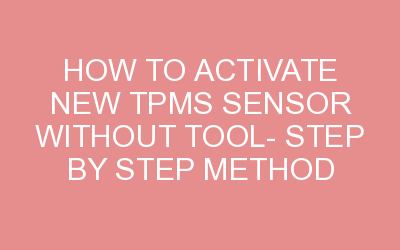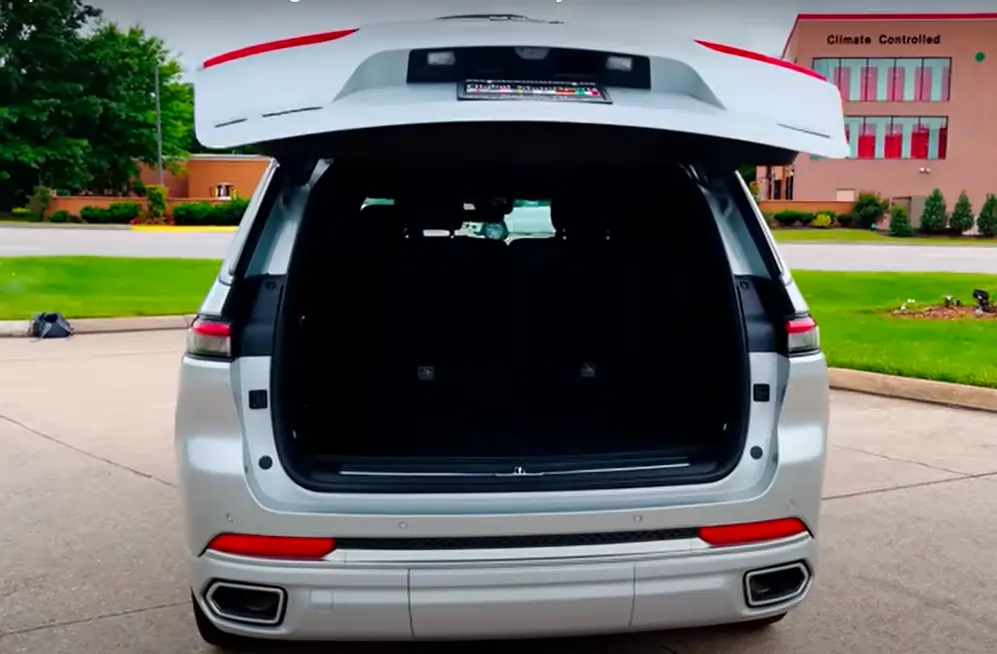Tire Pressure Monitoring Systems (TPMS) have become standard equipment in most modern vehicles, helping drivers maintain proper tire pressure. When getting new tires or TPMS sensors installed, it’s crucial to properly activate and reset the system so it functions correctly.
While some vehicles require special tools, many models allow TPMS sensor activation without any tools, using only the settings in your car.
In this comprehensive guide, we’ll walk through the complete process of activating new TPMS sensors without any tools on most common vehicle makes and models. Read on to learn the step-by-step method to successfully reset your TPMS and ensure accurate tire pressure readings.
What is a Tire Pressure Monitoring System?
A Tire Pressure Monitoring System (TPMS) is an electronic system designed to monitor the air pressure inside your tires. It uses sensors attached to each wheel that transmit tire pressure data to a central computer.
The TPMS alerts drivers when a tire is significantly underinflated, helping avoid blowouts or other tire failures. Most vehicles built after 2007 have a TPMS as standard equipment. Maintaining proper inflation is key for fuel economy, tread life, and performance.
The TPMS provides an early warning for low pressure so you can address issues before major problems occur.
When new TPMS sensors are installed, they must be properly activated and reset to work with the vehicle’s computer system.
When Do TPMS Sensors Need to Be Reset?
TPMS sensors have to be reset and calibrated any time new ones are installed. This is necessary when you:
– Get new tires (sensors are built into tire valves)
– Replace a damaged sensor
– Rotate tires to a different wheel position
Resetting establishes communication between the sensors and the car computer so it can monitor pressures accurately. Without resetting, the system won’t know the new sensor positions, meaning you won’t get pressure alerts when needed.
Tire shops will usually reset TPMS after new tires or rotations, but DIY installs require owners to reset it themselves. The process needs to be done even if swapping sensors between wheels, so the system recognizes the new sensor locations.
How to Activate TPMS Without Tools
The good news is that many modern vehicles allow TPMS reset and activation without any special tools or devices needed. Each automaker tends to have their own procedure, but they follow similar patterns:
1. Ensure tires are inflated to the correct pressures. Consult your owner’s manual or door jamb sticker.
2. Turn the ignition to the “on” position without starting the engine.
3. Locate the TPMS reset button or menu in the settings. Refer to your manual for its position.
4. Press the reset button or select the TPMS reset option on the menu. Hold or select as directed.
5. The TPMS light will flash, beep, or give some indication when activation begins.
6. Drive the car above 15 mph for at least 10-20 minutes for the reset to complete.
The sensors recognize their positions and the system confirms they’re functioning. Make sure to check pressures afterward with a gauge. Follow your owner’s manual exactly – methods vary between makes and models.
TPMS Reset Procedure for Popular Cars
The specific steps for non-tool TPMS initialization vary across car brands. Here are guides for some of the most common models:
Toyota:
1. Inflate tires and turn ignition to “on” (do not start engine).
2. Press and hold the reset button until the TPMS light blinks 3 times.
3. Drive above 25 mph for 10 minutes to set the sensors.
Honda:
1. Inflate tires and turn ignition on (do not start engine).
2. Press and hold the TPMS reset button until the light blinks twice.
3. Drive above 25 mph for 10-20 minutes.
Nissan:
1. Inflate tires and turn ignition on (do not start engine).
2. Toggle through the settings menu to highlight TPMS. Press “select.”
3. Confirm reset when prompted. The TPMS light will flash.
4. Drive above 25 mph for at least 15 minutes.
Consult your manual for the exact instructions for your vehicle make and model year. The general process will follow the same pattern – initialize, confirm reset, drive to complete.
How to Know When the Reset is Complete
Once you’ve initiated the reset, how do you know when it’s finished? Here are the signs the TPMS has completed activation and reset without tools:
– The low tire pressure warning light will stop flashing and stay off after driving for 10-20 minutes above the specified speed.
– The tire pressures may display in the dashboard menu, confirming communication.
– No TPMS error messages should be displayed on dashboard readout screens.
– Most importantly, check each tire with a pressure gauge. They should match the placard recommendation if reset is complete.
If warning lights stay on or pressures don’t display, the reset may not have been activated. Retry the procedure and drive longer – it can take up to 30 minutes of cumulative driving. If issues persist, consult your owner’s manual or dealer.
Troubleshooting TPMS Reset Issues
While most TPMS systems can be reset without tools, you may encounter issues during the process:
– If tires are significantly underinflated, correction may be needed before the reset initializes.
– Interference from devices like cell chargers can disrupt the sensor signal. Unplug all accessories during reset.
– Sensor batteries may be dead if a sensor was sitting unused for long periods. Replacements may be needed.
– Metal wheel cleaner or moisture buildup on wheels can affect sensor functionality. Clean dry wheels thoroughly before reset.
– Driving shorter distances, in traffic, or at lower speeds can prolong the drive time needed to complete activation. Take it on the highway.
– Consult your owner’s manual or dealer if the light stays on after multiple reset attempts. More advanced diagnostics may be required.
Be patient, follow all steps carefully, and take an extended test drive to allow system calibration if running into issues during self-reset procedures.
How Often Should TPMS Sensors Be Reset?
Any time you remove or replace a TPMS sensor, activation and reset is required. So how often should you plan to reset them? General guidelines include:
– When installing new tires – sensors are built into valve stems
– After rotating tires for even treadwear or moving to winter wheels
– Following TPMS sensor replacement due to malfunction or dead battery
– Performing maintenance like brake service that requires sensor removal
– Checking pressures during regular maintenance and finding significantly low tires
– Noticing TPMS warning light illuminated indicating sensor issue
Ideally, TPMS should be reset 2-4 times per year corresponding with tire rotations or changes. But also reset immediately if you see an issue with tire pressures or sensor operation.
Frequently Ask Question
How do I program TPMS sensors without tools?
Most vehicles allow TPMS reset without tools – just an ignition on/off cycle and driving above 15 mph. Steps vary by automaker but generally involve: 1) Inflate tires properly 2) Turn ignition on 3) Initiate sensor reset through car settings 4) Drive continuously above 15 mph for 10-20 minutes. Check your manual for the specific procedure. Tool resets are only needed on some older or luxury models.
Why won’t my TPMS light turn off after reset?
If the TPMS warning light stays on after a reset, the sensors may not have calibrated. Try driving longer distances above 25 mph. Park away from devices that cause interference.
Make sure all tires are inflated properly and wheels are clean. Persistent issues could mean a dead sensor battery or other malfunction. Take me to a shop for a diagnosis. Proper resets should turn the light off within 10-20 minutes of driving.
Do I need to reset TPMS when rotating tires?
Yes, the TPMS sensors must be reset after every tire rotation. This allows the system to re-learn the new location of each sensor so tire pressures display accurately.
Without resetting, the vehicle computer will think the sensor is still at the previous wheel position. Follow your owner’s manual reset procedure after each rotation to ensure you get proper pressure alerts at the correct wheel.
Conclusion
Properly maintaining your Tire Pressure Monitoring System is crucial for safe driving and avoiding blowouts. While shops can reset TPMS after tire service, many models allow owners to activate new sensors without any special tools or equipment using settings menus and reset buttons.
Make sure you know the manufacturer-specific procedure for your vehicle. Activation steps may vary across car makers but follow the same basic pattern – inflate tires, enable sensor reset mode, drive 10+ minutes above 15 mph. Pay close attention to any indicator lights confirming successful calibration.
Check pressures with a gauge after reset is complete. Take an extended test drive if issues pop up to give the TPMS system time to fully activate the new sensor positions. While the exact steps differ across automakers, modern vehicles are designed to allow DIY resets without needing costly dealer diagnostic tools.
With a little time and patience, vehicle owners can successfully activate and reset new TPMS sensors to keep tire pressures optimized for safety and performance.














Leave a Reply